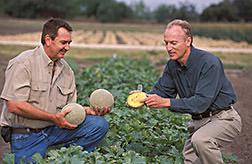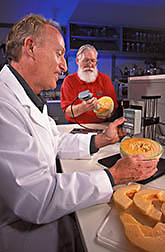Kicking Up Nutrients in Melons and Income in Growers’ Pockets
Fruits and vegetables are known for their health-promoting levels of vitamins and minerals. But what if you could improve their phytonutrient content? That’s what ARS researchers in Oklahoma and Texas are doing for melons—watermelons, cantaloupes, and honeydews.
The United States is one of the world’s leading producers and consumers of melons. Total U.S. per capita consumption has increased by more than 23 percent in the past 15 years to almost 30 pounds per person in 2004. Only bananas, with a 7-percent increase in consumption over this period, can compare with melons.
The three most-consumed melons are watermelon (about 14 pounds per person per year), cantaloupe (about 11 pounds), and honeydew (about 2 pounds). The domestic farmgate melon crop is valued at more than $800 million, and the annual retail of all melons—including imports—likely averages $3 billion to $4 billion.
“The popularity of melons has never been higher,” says Gene Lester, a postharvest plant physiologist in ARS’s Crop Quality and Fruit Insects Research Unit, in Weslaco, Texas. “If we can improve their quality, we can provide even more opportunities for melon growers to increase profits while adding nutritional value for consumers.”
Working with the largest cantaloupe and honeydew melon growers in Texas and with other collaborators, Lester has extensively studied applying potassium as a foliar spray during melon fruit development. The potassium formulation is relatively simple, inexpensive, safe, and readily available, he says.
In greenhouse and field studies using popular commercial melon varieties, applying potassium specifically during fruit development greatly increased levels of beta-carotene. A powerful dietary antioxidant, beta-carotene regulates one of the most damaging reactive oxygen types—singlet oxygen (also known as unstable, energy-rich, active oxygen)—in humans.
Foliar application of potassium also aided the plants’ photosynthesis, ultimately increasing the fruit’s sugar content, which in turn raised levels of vitamin C.
|
|
“Consumers will get not only a better tasting, sweeter melon, but one that can help boost their intake of beta-carotene and vitamin C,” says Lester, who has been working at the Kika de la Garza Subtropical Agricultural Research Center in Weslaco since 1983. “And all these great benefits can be achieved with minimal cost.”
Eventually, bumping up melon nutrients could lead to a gourmet-type fruit with at least 11 percent sugar, which would receive a U.S. Fancy grading and could fill demands of high-end restaurants and gourmet markets.
Two potassium formulas were used: potassium linked with glycine (a protein-building amino acid from soybeans) or potassium chloride (a table salt substitute). Lester applied either of these food-grade compounds once a week during the growing season—a 4- to 6-week period—in spring or fall. It’s absorbed through plant leaves and the developing melon’s skin. The formula can also be mixed with pesticides or other chemicals for more efficient application. The glycine-potassium mix worked generally better than the potassium chloride, but both were superior to no potassium, Lester says.
Lester is working closely with melon growers at Starr Produce in Rio Grande City, the top fruit producer in south Texas and one of the main produce providers to H-E-B of Kerrville, Texas, a large supermarket chain. Starr provided Lester with several acres of land on which to test his potassium solution and the labor needed to apply it to the test plants. Other collaborators in the study included Albion Advanced Nutrition of Clearfield, Utah; the Australian Melon Association, Inc., of Melbourne; the Potash and Phosphate Institute of Norcross, Georgia; and the Texas A&M Agricultural Research and Extension Center in Weslaco.
After gathering data from collaborators, Lester studied and analyzed all the results. So far, after two melon harvests, potassium and other nutrient levels in the fruit have increased significantly without any complications. The potassium-treated fruit mature 2 to 3 days earlier, and growers like that.
|
|
Calcium Enhancements Also Studied
Lester and fellow USDA-ARS colleague Mike Grusak at the Children’s Nutrition Research Center in Houston worked previously with Albion, a manufacturer and exporter of dietary supplements. They collaborated in a study of calcium applications for honeydews and cantaloupes on the vine as a supplement to, or alternative for, postharvest treatments to preserve quality. [See “Melons Are on a Roll,” Agricultural Research, February 1999, pp. 18-19.]
Not only does calcium contribute to building strong bones in humans, it also helps melons develop stronger rind tissue. The shelf life of ripe melons is usually less than 12 days, but it nearly doubled when the fruit was treated with calcium in greenhouse tests. Calcium applications enable growers to provide more nutritious, vine-ripened melons in greater quantities to distant markets—specifically honeydew melons to Japan.
While doing the calcium research, Lester discovered that cantaloupe and orange-fleshed honeydew melons grown in high-potassium soils had slightly greater beta-carotene levels, but the potassium competed with the roots’ uptake of other essential minerals. He found a cost-effective solution to that problem in applying potassium during fruit growth, when the root’s ability to take up potassium is poorest.
Lester’s calcium and potassium research can be combined to further improve overall quality of melons. The results of his calcium research are being applied by other researchers and growers to crops grown elsewhere in the world, such as watermelon, chilies, tomatoes, papayas, bananas, and squash.
Growers and industry representatives involved with these crops are committed to promoting this innovative concept. And they strongly believe in the potential economic rewards of Lester’s research, which has been published in the Journal of the American Society for Horticultural Science.—By Alfredo Flores, Agricultural Research Service Information Staff.
This research is part of Quality and Utilization of Agricultural Products, an ARS National Program (#306) described on the World Wide Web at www.nps.ars.usda.gov.
Gene E. Lester is with the USDA-ARS Kika de la Garza Subtropical Agricultural Research Center, 2413 E. Bus. Hwy. 83, Weslaco, TX 78596; phone (956) 447-6322, fax (956) 447-6345.
"Kicking Up Nutrients in Melons and Income in Growers’ Pockets" was published in the August 2005 issue of Agricultural Research magazine.









